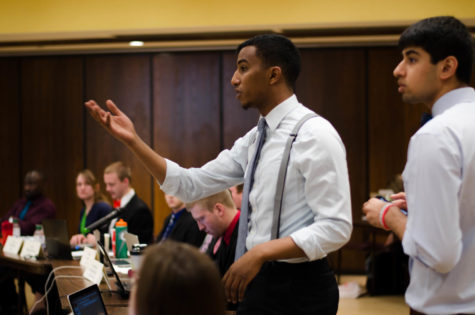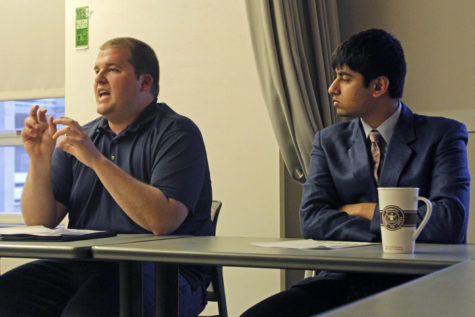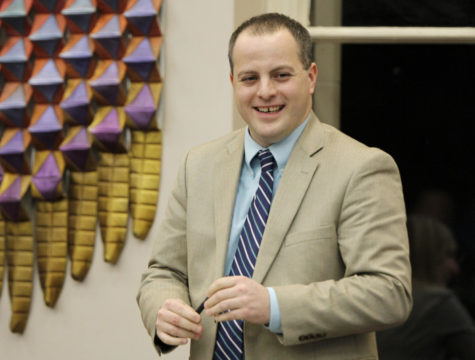Power plant works to create fuel diversity, phase out coal burning
January 27, 2012
The ISU coal power plant is working to create fuel diversity by taking small steps away from coal dependence.
The university strives to be a leader in sustainability and has initiated changes in the diversity of energy sources and the operations of the coal power plant. In addition to university initiatives, recent federal regulations have prioritized changes in coal use with reduced emissions regulations.
In March 2011, Maximum Achievable Control Technology standards were released by the Environment Protection Agency. These standards are part of the 1990 Clean Air Act and regulate the amount of hazardous air pollutants and set a new baseline of emission control.
Jeff Witt, director of the ISU power plant, said that because of the new MACT standards, a study on efficiency and emissions was done by the power plant. Alongside a consultant group, the coal power plant was able to propose solutions for meeting the new regulations.
The plant currently has five coal boilers and burns 154,463 tons of coal annually.
The power plant plans to keep two of the newest and most efficient boilers burning coal and potentially biomass. The three oldest coal boilers will switch to burning natural gas.
Witt said he believes this will allow for some fuel diversity. The plant will ideally be able to switch between natural gas, coal and biomass, he said.
Witt said he believes this option has been chosen because it is the most forward-thinking option by providing fuel diversity.
Coal is considered outdated and unhealthy by a growing public opinion. When coal burns, it emits carbon dioxide — a greenhouse gas — sulfur dioxide, and various oxides of nitrogen. Much like the burning of any fossil fuel, carbon dioxide released from coal into the atmosphere is linked to climate change, according to the EPA. In addition, coal-fired power plants emit mercury, selenium and arsenic, which are harmful to human health and the environment.
According to the EPA, as the environmental and health effects of coal have become evident, the American public has pressured legislative and social change. The ISU coal power plant has received criticism from students, organizations and experienced increasing federal regulations. But, Witt said, the plant has proactively used the criticism to become a forward-thinking producer of campus energy.
Public opinion and anti-coal groups have played an influential role in pressuring a change in coal power plants worldwide. At Iowa State, an environmental student organization focused on pressuring change is ActivUS. Emily Kathrein, president of ActivUS, said the group believes if Iowa State is serious about being a leader in sustainability, it absolutely must move beyond the burning of tens of thousands of tons of coal each year.
ActivUS has worked in the past years to increase awareness about environmental and social justice issues of campus, especially on the use of coal. ActivUS has worked to gain public attention through events such as the 5k Run Beyond Coal and coal demonstrations that educate students about the effects of burning coal.
“Public opinion and groups like ActivUS are part of the reason for the changed regulations from the EPA,” Witt said. “The power plant has been looking into alternative energy sources for years; the changes aren’t solely because of EPA regulations.”
Merry Rankin, Iowa State’s director of sustainability, said discussion of doing the minimum and simply complying with the new EPA regulations has never been a discussion.
“The leaders of the power plant are very forward-thinking. They are constantly looking for better and other opportunities beyond coal and other nonrenewable power sources,” she said.
Iowa State has used cogeneration, a process that uses the same fuel source twice to produce electricity and other energy, since 1891. Each year, more than 83 percent of steam used to produce chilled water and 98 percent of steam used to produce electricity is first produced through cogeneration. This reduces coal burned by 15,000 tons annually and saves the university $1.2 million. In addition, cogeneration reduces carbon emissions by 37,00 tons, or 39 percent.
“Cogeneration is the right thing to do because it is very efficient and has been good for the university and is independent of the fuel source,” Witt said.
In addition to internally redesigning parts of the coal plant, the university has begun utilizing renewable energy.
In January 2010, the university contracted with NextEra Enegry, a wind farm north of Ames, to use wind energy for 10 percent of the university’s annual energy demand.
The Iowa State Daily reported at the beginning of the contract in 2010, “the wind power will also eliminate the need for an estimated 9,000 tons of coal per year.”
The university only ended up using 4.4 percent of the contracted energy the first year because of a lack of transmission capacity, Rankin said.
“The infrastructure just isn’t quite there to make a complete switch,” she said. “It isn’t a reason not to do it; it is just a reality of when and how quickly it can be done.”
So far in 2011, the university has raised its use of wind energy from 4.4 percent to around 6 percent. It is an improvement due to infrastructure and is a process that takes time to fall into place, Rankin said.
Witt said he believes changes for greener energy are ideal, but changes come down to paying the bills. All energy changes will result in university spending. According to the GSB presentation on Nov. 2, reported in the Iowa State Daily, the planned coal power plant changes are expected to cost about $11 million.
Kathrein also said the inhibitor of energy change comes down to money.
“It would cost millions of dollars and many years to phase out coal,” she said. “Students would most likely see changes in their tuition as well.”
With the proposed changes within the power plant, sustainability, cost and timeliness were all considered.
“The rationale that we recommend is minimizing costs for the university,” Witt said. “These changes are going to result in a cost increase, but we looked at what is the best choice for the university long-term.”
Rankin praised the work of the coal plant in opening up discussion and allowing community engagement while making decisions about the power plant changes.
“It has taken more effort and time to include everybody in these proposals, but that has made the process thoughtful and respectful,” she said.
In examining a change that students and faculty can make immediately to reduce coal emissions, conservation is key, Witt said. Rankin also said she believes that individuals can literally make a change today by being cognizant of how they use energy resources.
“The fact of the matter is we burn the coal here [at the power plant], but we have no control over how much we burn,” Witt said.
It is the people using the energy, turning on the lights and cranking up the thermostat that control how much coal Iowa State burns, he said.
While the power plant is directly related to sustainability considerations, Rankin said she believes that it is a university effort making the changes.
“Because of a university effort from a variety of sources, we have a big picture of the concerns, the opportunities, and the challenges,” Rankin said.
Rankin said she sees so many people interested in conservation and she sees that sustainability has become a mainstream.
“People want to know what are we going to do about our energy crises,” she said.
She said she is excited that there is so much engagement from the public and ISU community.
Iowa State has a variety of student organizations, including ActivUS, that focus on conservation and environmental issues. Kathrein said ActivUS works to provide the necessary tools for students to get involved in the university’s transition to a more sustainable form of energy.
“Students come to me with so much enthusiasm,” Rankin said. “We try to keep the momentum and synergy going because the discussion that goes on is a good discussion to have. It increases the impact we are making in sustainability.
Discussions and interest are necessary for the progression of sustainability on campus, Rankin stated.
“People need to know where their energy comes from because many people don’t think about it,” Witt said. “It is a good thing to make people aware of because most people don’t get it.”









